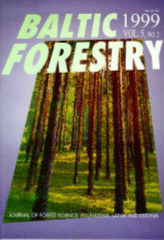Pilichowski, S.* and Giertych, M. J. 2017. Gall Abundance and Leaf Size as Factors Affecting the Hypersensitive Reaction in the Common Beech (Fagus sylvatica). Baltic Forestry 23(3): 608-611
Plant galls being abnormal growths can alter the hypersensitive reaction (HR), a defensive mechanism that is supposed to kill pathogens, parasites and all other alien organisms, including gall-inducers. The aim of the study was to find an answer to the question, whether leaves of different size react similarly to a various number of galls of Mikiola fagi and Hartigiola annulipes. Leaves (3,179 with 7,011 galls of H. annulipes and 482 with 637 galls of M. fagi) from seven localities, including two nature reserves, were collected in western Poland in 2014. Analyses conducted as the logistic regression test showed that the HR in large leaves as reaction against H. annulipes was more often (but not statistically significant) than in small leaves. This trend was not observed in the case of M. fagi while there was no relationship between the HR and the leaf size for M. fagi. However, the linear regression test for both species showed a relationship between HR occurrence and the number of galls on the leaf blade.
Keywords: hypersensitive reaction, galls, Hartigiola annulipes, Mikiola fagi, beech
Vasinauskienė, R. and Šilingienė, G. 2016. Temperature Field Distribution Character in the Upper Soil Layer of Forest Nurseries after Water Steam Treatment. Baltic Forestry 22(2): 297-306.
Ecologization of agriculture and forestry directly and indirectly influences the environment, water, air, and landscape. Therefore, analysis of ecological forestry activities, evaluation and forecast are of scientific, ecological and political significance. Weed control and the resulting ecological farming and forestry issues have attracted greater attention to the use of physical methods in weed control, because this weed control method is effective and does not leave chemical residues neither in the soil, nor in water. One of the physical methods is thermal weed control method, which contrary to the other weed control methods, leaves only dead biomass, preventing self sowing of weed seeds in the soil, destroys some of the pests and disinfects the surface layer of soil. However, it is very important to examine the possibilities of wet water steam dispersion in soil. The aim of the study was to determine temperature field distribution character and intensity in the upper layer of the inter-beds soil in forest nurseries. All analyses were carried out using air-dry soil (Calc(ar)i-Epihypoglevic Luvisol, LVg-p-w-cc(sc)) passed through 1.7 mm sieve. Temperature field distribution character and its intensity in the upper soil layer was registered using 0.19 mm diameter nickelchrome thermocouples, arranging them in the measuring planes according to the measuring schemes prepared in advance. The change of temperature field was registered using Almemo device. Study results showed the dependence of temperature field distribution character and intensity upon the duration of wet water steam supply, steam amount and overpressure under the cover. The data showed that weed seedlings in the depth of 0.5–2.5 cm would be killed treating the soil with wet water steam for 3060 seconds. The results of the analysis provide a possibility to supplement the common existing weed control system using wet water steam with additional technology – weed seeds control in the upper soil layer.
Keywords: weed seeds, the upper soil layer, water steam, temperature field.
Stöd, R., Verkasalo, E. and Heinonen, J. 2016. Quality and Bending Properties of Sawn Timber from Commercial Thinnings of Scots Pine (Pinus sylvestris L.). Baltic Forestry 22(1): 148-162.
In this study, the visual characteristics and static bending properties of Scots pine (Pinus sylvestris L.) sawn timber were determined using the material collected from thinning and final-felling stands in eastern Finland. The quality of boards was assessed based on the Nordic visual strength grading rules for timber, and the bending strength, and modulus of elasticity were determined according to the European standard test EN 408. Based on the visual strength grading, the majority of boards met the requirements of the visual grade T1, whereas the highest grade T3 was achieved by less than 10% of the boards. The bending strength and modulus of elasticity of sawn timber from the first thinnings were 42.0MPa and 10.2GPa, and those from the second thinnings 52.6MPa and 12.8.GPa, respectively. The distribution of theoretic strength classes indicated a strong focus on C30 or higher for the material from the second thinnings, whereas the strength classes of C24 or lower were most common for the material from the first thinnings. Regarding the bending properties, the sawn timber from the butt logs of the first-thinning trees was comparable with that of the middle or top logs from later cuttings. The strength and modulus of elasticity of the first-thinning material were relatively low, whereas the Scots pine sawn timber from the second commercial thinnings may be comparable with that from the current final fellings.
Keywords: bending strength, modulus of elasticity, visual strength grading, Pinus sylvestris L., sawn timber, structural products, thinning.
Turek, K., Kamler, J.* and Procházka, L. 2016. The Impact of Thinning Type on Bark Stripping Damage Intensity Caused by Red deer (Cervus elaphus L.). Baltic Forestry 22(2): 246-250.
The aim of this study was to identify the influence of forest thinning methods on bark stripping damage caused by red deer. It was assumed that spruce stem bark damage would be higher in stands with target trees only than in stands including other non-target (sunken) spruce trees. In the ten-year-old spruce stands four types of thinning were performed (positive, negative, schematic and conical). All tested thinning methods provided attractive refuge for red deer during winter season. The differences in bark stripping damage intensity clearly proved that the presence of indifferent trees in the stand significantly reduces target tree damage. Indifferent trees growing in close proximity to a target tree significantly reduced the risk of bark stripping damage by red deer. Presence of indifferent trees in tested stands had low influence on target trees growth. We recommend leaving of indifferent (sunken) trees in stands endangered by deer bark stripping.
Keywords: bark stripping, thinning method, red deer, spruce, even-aged and structured stands.
Welcome to Baltic Forestry
-
12. 01. 17

![]() BALTIC FORESTRY ISSN 1392-1355
BALTIC FORESTRY ISSN 1392-1355
is peer reviewed international scientific journal of forest sciences. Baltic Forestry is open access journal. Open access means that all content is freely available without charge to the user or his/her institution. Users are allowed to read, download, copy, distribute, print, search, or link to the full texts of the articles, or use them for any other lawful purpose, without asking prior permission from the publisher or the author. This is in accordance with the BOAI definition of open access. Baltic Forestry is indexed/covered in Clarivate Analytics products (Journal Citation Reports - Science Edition (JCR), Science Citation Index - Expanded, Zoological Records), Elsevier Products (Scopus™) and other databases. The journal does not charge authors from founder institutions with processing fees.
The journal welcomes the original articles as well as short reports, review papers on forestry and forest science throughout the Baltic Sea region and elsewhere in the area of boreal and temperate forests. The Baltic Sea region is rather unique through its intrinsic environment and distinguished geographical and social conditions. A temperate climate, transitional and continental, has influenced formation of the mixed coniferous and deciduous stands of high productivity and biological diversity. The forest science has been affected by the ideas from both the East and West.
In 1995, Forest Research Institutes and Universities from Estonia, Latvia and Lithuania
joined their efforts to publish BALTIC FORESTRY.
Journal Publisher:
- Institute of Forestry, Lithuanian Research Centre for Agriculture and Forestry (LAMMC)
- Vytautas Magnus University Agriculture Academy
- Institute of Forestry and Rural Engineering - Estonian University of Life Sciences
- Latvian State Forest Reseach Institute "Silava"
- Latvia University of Life Sciences and Technologies
E-mail: This email address is being protected from spambots. You need JavaScript enabled to view it.
